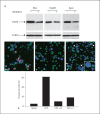Regulation of extracellular chromatin release from neutrophils
- PMID: 20375577
- PMCID: PMC6951038
- DOI: 10.1159/000206974
Regulation of extracellular chromatin release from neutrophils
Abstract
Neutrophils use intricate mechanisms for capturing and killing invading microorganisms. One mechanism entails the release of relaxed chromatin from the cell. Microbes are trapped by the extracellular chromatin and exposed to high local concentrations of bactericidal compounds. We examine the regulation of chromatin release by testing the contribution of microtubules and the actin cytoskeleton to the deployment of neutrophil extracellular traps (NETs). Incubation of human neutrophils with nocodazole, a tubulin polymerization inhibitor, or cytochalasin D, an inhibitor of actin filamentation, severely diminished the ability of neutrophils to respond to LPS by releasing chromatin from the cells. In addition, pretreatment of neutrophils with M1/70, a monoclonal antibody to the Mac-1 integrin adhesion receptor, drastically reduced the deployment of chromatin into NETs. Analysis of histone deimination, the conversion of arginine to citrulline in 3 of the 4 core histones by peptidylarginine deiminase 4, revealed that the treatments inhibiting NET formation also reduced histone deimination. Our data indicate that NET formation requires functional tubulin and actin filaments and responds to engagement of Mac-1 integrins. Because histone deimination coincides with the release of NETs, we propose that these events represent overlapping mechanisms of neutrophil responses to infections.
Copyright 2009 S. Karger AG, Basel.
Figures



Similar articles
-
Histone deimination as a response to inflammatory stimuli in neutrophils.J Immunol. 2008 Feb 1;180(3):1895-902. doi: 10.4049/jimmunol.180.3.1895. J Immunol. 2008. PMID: 18209087
-
Neutrophil attachment via Mac-1 (αMβ2; CD11b/CD18; CR3) integrins induces PAD4 deimination of profilin and histone H3.Philos Trans R Soc Lond B Biol Sci. 2023 Nov 20;378(1890):20220247. doi: 10.1098/rstb.2022.0247. Epub 2023 Oct 2. Philos Trans R Soc Lond B Biol Sci. 2023. PMID: 37778386 Free PMC article.
-
NETosis proceeds by cytoskeleton and endomembrane disassembly and PAD4-mediated chromatin decondensation and nuclear envelope rupture.Proc Natl Acad Sci U S A. 2020 Mar 31;117(13):7326-7337. doi: 10.1073/pnas.1909546117. Epub 2020 Mar 13. Proc Natl Acad Sci U S A. 2020. PMID: 32170015 Free PMC article.
-
Citrullinated Autoantigens: From Diagnostic Markers to Pathogenetic Mechanisms.Clin Rev Allergy Immunol. 2015 Oct;49(2):232-9. doi: 10.1007/s12016-014-8459-2. Clin Rev Allergy Immunol. 2015. PMID: 25355199 Review.
-
NETs: a new strategy for using old weapons.Trends Immunol. 2009 Nov;30(11):513-21. doi: 10.1016/j.it.2009.07.011. Epub 2009 Aug 21. Trends Immunol. 2009. PMID: 19699684 Review.
Cited by
-
Neutrophil Extracellular Traps: Signaling Properties and Disease Relevance.Mediators Inflamm. 2020 Jul 28;2020:9254087. doi: 10.1155/2020/9254087. eCollection 2020. Mediators Inflamm. 2020. PMID: 32774152 Free PMC article. Review.
-
Interleukin-17-induced neutrophil extracellular traps mediate resistance to checkpoint blockade in pancreatic cancer.J Exp Med. 2020 Dec 7;217(12):e20190354. doi: 10.1084/jem.20190354. J Exp Med. 2020. PMID: 32860704 Free PMC article.
-
Cyclic stretch enhances neutrophil extracellular trap formation.BMC Biol. 2024 Sep 18;22(1):209. doi: 10.1186/s12915-024-02009-6. BMC Biol. 2024. PMID: 39289752 Free PMC article.
-
Neutrophil NET Formation with Microbial Stimuli Requires Late Stage NADPH Oxidase Activity.Antioxidants (Basel). 2021 Nov 9;10(11):1791. doi: 10.3390/antiox10111791. Antioxidants (Basel). 2021. PMID: 34829662 Free PMC article.
-
[LPS stimulating neutrophils firmly adhered to ICAM-1 to form extracellular traps depends on integrin Mac-1 and cytoskeletal proteins].Sheng Wu Yi Xue Gong Cheng Xue Za Zhi. 2021 Oct 25;38(5):903-910. doi: 10.7507/1001-5515.202105019. Sheng Wu Yi Xue Gong Cheng Xue Za Zhi. 2021. PMID: 34713658 Free PMC article. Chinese.
References
-
- Nathan C. Neutrophils and immunity: challenges and opportunities. Nat Rev Immunol. 2006;6:173–182. - PubMed
-
- Medzhitov R. Origin and physiological roles of inflammation. Nature. 2008;454:428–435. - PubMed
-
- Ley K, Laudanna C, Cybulsky MI, Nourshargh S. Getting to the site of inflammation: the leukocyte adhesion cascade updated. Nat Rev Immunol. 2007;7:678–689. - PubMed
Publication types
MeSH terms
Substances
LinkOut - more resources
Full Text Sources
Research Materials

